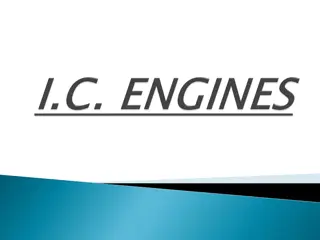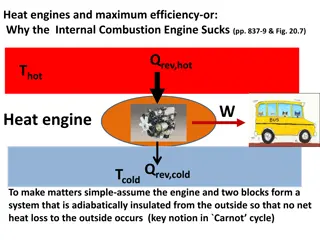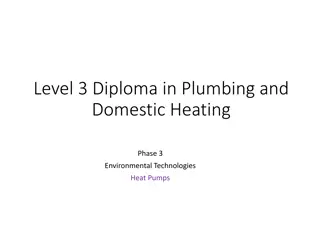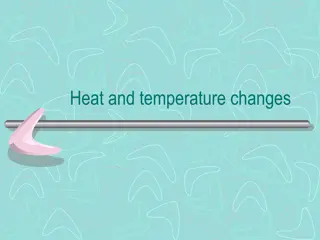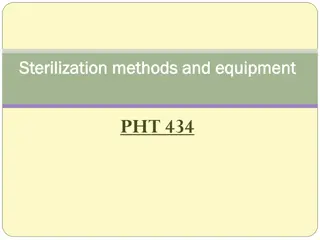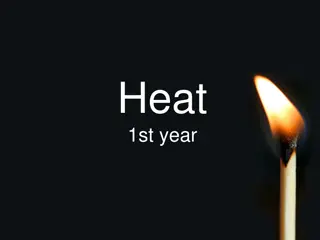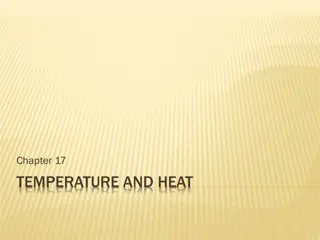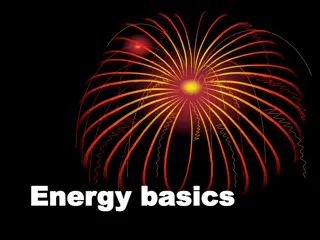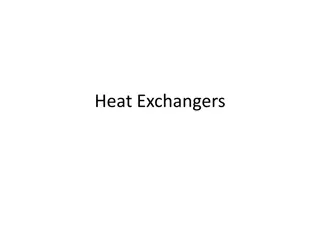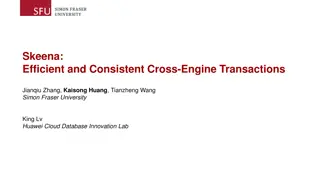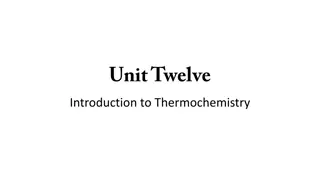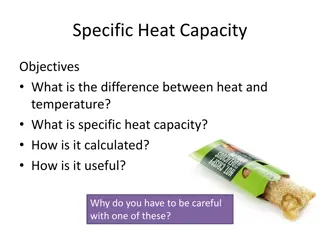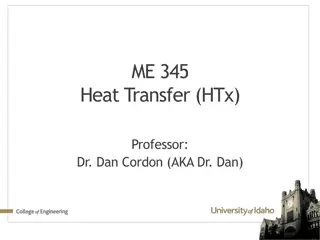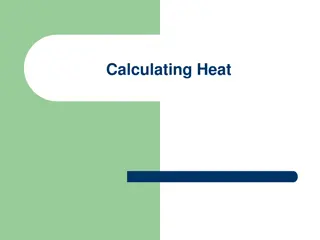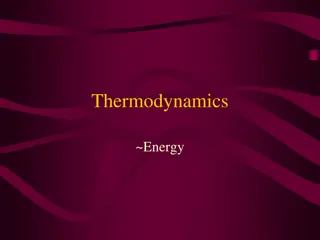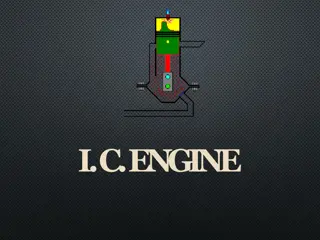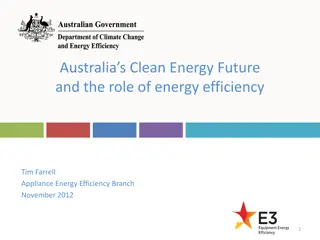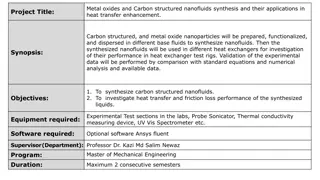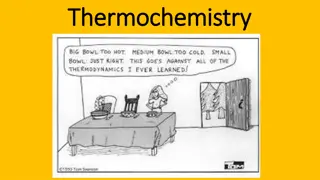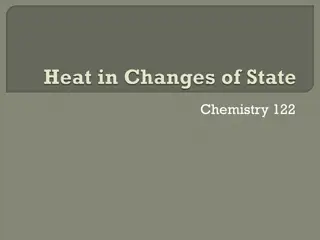Understanding Heat Engines: Concepts, Efficiency, and Energy Flow
Explore the fundamentals of heat engines through topics like the Carnot cycle, energy flow, and problem-solving examples. Learn about heat pumps, efficiency calculations, and the relationship between heat, work, and temperature in various engine scenarios.
Download Presentation

Please find below an Image/Link to download the presentation.
The content on the website is provided AS IS for your information and personal use only. It may not be sold, licensed, or shared on other websites without obtaining consent from the author. Download presentation by click this link. If you encounter any issues during the download, it is possible that the publisher has removed the file from their server.
E N D
Presentation Transcript
Heat Engines Contents: Basic Concept Carnot cycle Energy flow Solving problems Whiteboards Heat Pumps Whiteboard
Energy Flow Qh - Heat that flows from boiler Th - Temperature K of boiler W - Work done by engine c Qc - Heat that flows to condenser Tc - Temperature K of condenser Qh = Qc + W c
Qh = Qc + W Q 1 Q 1 W = = h c e e c c
Example: A heat engine consumes 145 J of heat and wastes 97.0 J. What work does it do, and what is its efficiency? c c 48.0 J, 0.331 or 33.1 %
Example: A heat engine is 22.0% efficient. If it wastes heat at a rate of 615 W, A. At what (Watt?) rate does it do useful work? B. At what rate does it consume heat from the boiler? 173 W, 788 W
Gotelit Andamantan has a heat engine that uses 85.0 J of heat from the boiler, and wastes 60.0 J of heat. A. What amount of work does the engine do? B. What is the efficiency of the engine? Qh = Qc + W, Qh = 85 J, Qc = 60. J, W = ??? 25.0 J, 0.294 or 29.4%
Ms Ribble has a steam engine that puts out work at a rate of 742 W, and consumes heat from the boiler at a rate of 995 W. A. At what (Watt) rate does heat flow to the condenser? (Wasted) B. What is the efficiency of the engine? Qh = Qc + W, Qh = 995 J, Qc = ???, W = 742 W Treat Watts the same as work, only it is a rate of work (J/s) 253 W, 0.746 or 74.6%
Miss Direction has a heat engine that wastes heat at a rate of 624 W, and does work at a rate of 225 W. A. At what (Watt?) rate does it consume heat from the boiler? B. What is the efficiency of the engine? solution 849 W, 0.265 or 26.5 %
Hugh Jass has a heat engine that is 53.0 % efficient, and consumes 512 J of heat from the boiler. A. What work does it do? B. What heat does it waste? solution 271 J, 241 J
Mr. Fyes heat engine is 5.54 % efficient. If it does work as a rate of 113 Watts A. at what rate does it waste heat B. at what rate does it consume heat from the boiler? Qh = Qc + W, Qh = ??? J, Qc = 23 J, W = 34 J 1927 W, 2040 W
Mr. Meaners heat engine is 34.7% efficient. If it wastes 12.0 J of heat, A. what work does it do, and B. what heat does it pull from the boiler? Qh = Qc + W, Qh = ??? J, Qc = 23 J, W = 34 J 6.38 J, 18.4 J
Carnot Cycle Maximum efficiency possible:
Example: A heat engine operates at its Carnot efficiency. (i.e. it Carnot be more efficient) between the temperatures of 415 oC and 303 oC, doing work at a rate of 320. W. What is its efficiency, at what rate does heat flow from the boiler, and at what rate is heat wasted? 0.163, 1970 W, 1650 W
Carnot efficiency 1 | 2 | 3 | 4 TOC
Amanda Huggenkis operates a Sterling engine between the temperatures of 35.0 oC and 13.0 oC. What is the maximum theoretical efficiency she can achieve? (Carnot efficiency) efficiency = Th-Tc Th (Carnot cycle) Th = 35 + 273 K, Tc = 13 + 273 K, efficiency = ??? efficiency = .0714 or 7.14% .0714 or 7.14%
Amanda Huggenkis operates a Sterling engine between the temperatures of 35.0 oC and 13.0 oC. If the engine is to do 134 J of work, what heat must flow from the high temperature, and what heat is wasted? Hint - we already know that efficiency = 0.071429 efficiency = Qh-Qc Qh Qh -Qc = W = 134 J, Qc = ???, Qh = ???, efficiency = .071429 Qh = 1876 J, 1876 - 134 = Qc = 1742 J 1876 J, and 1742 is wasted
Kahn and Stan Tinople have a heat engine with a Carnot efficiency of 0.35, if the low temperature is 285 K, what must be the high temperature? (Assume Carnot efficiency) efficiency = Th-Tc Th (Carnot cycle) Th = ??, Tc = 285 K, efficiency = .35 Th = 438 K = 440 K 440 K
Olive Hughe has a heat engine that does 25.0 J of work, and wastes 41.0 J of heat during a cycle. If the low temperature is 20.0 oC, what must be the high temperature in Celsius? (Assume Carnot efficiency) Qh = Qc Th = Tc (Carnot cycle) Qh = 25 + 41 J, Qc = 41 J, Tc = 273 + 20 K, Th = ??? Th = 472 K = 199 oC 472 K or 199 oC
Heat Pumps Example: A refrigerator has a temperature of -21.0 oC in its ice box, and operates in a room where the temperature is 28.0 oC. What work does the compressor need to do to make 100. J flow from the ice box to the room? What heat is exhausted to the room? (assume Carnot efficiency) 19.4 J, 119.4 J
Heat Pumps Does a heat pump really have an efficiency more than 1?
Heat Pumps 1| 2
Eliza Lott has an air conditioner that operates between the temperature of 18.0 oC (inside the house) and 35.0 oC (outside the house). If the air conditioner pumps 1200. J of heat outside, how much work did it do, and how much heat was removed from the house? (assume Carnot efficiency) Qh = Qc Th = Tc (Carnot cycle) Qh = 1200. J, Qc = ??, Th = 273 + 35 K, Th = 273 + 18 K Qc = 1133.8 J = 1130 J, W = 1200. - 1133.8 = 66 J 66.2 J, 1130 J
Frank Le Spekin heats his house with a heat pump, the hot side of which is inside his house at 24.0 oC, and the pump takes heat from outside which is at -12.0 oC. Assuming the pump operates at 85.0% Carnot efficiency, what work does the pump do to bring 1500. J of heat into the house? (Multiply the Carnot efficiency by 0.850) Carnot e = Th-Tc = 24-(-12) = .12121212 Th (273+24) efficiency = .85(.121212) = .10303 = W/Qh = W/(1500 J) W = 154 J 154 J


